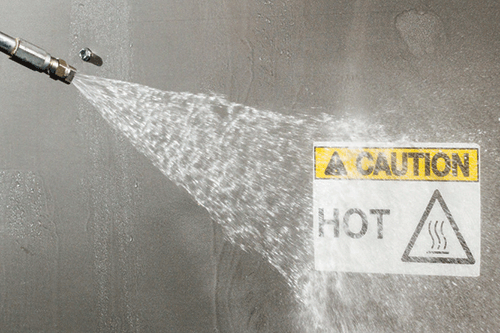Not all signs and labels are created equal
What are the sign/label options for harsh environments?

Responding is Tom Smith, product marketing specialist for Brady Worldwide Inc., Milwaukee.
You’re the environmental, health and safety manager for a food processing plant that makes commercial soups for large chain restaurants. You need a “CAUTION: HOT” label to warn your employees of the burn hazard of hot stainless steel kettles filled with chicken broth. You’re frustrated by having to replace these labels frequently.
Or, you’re the maintenance supervisor for an oil and gas refinery. As you walk past the large outdoor tanks and pipes, you realize that you can’t read the “CONFINED SPACE” sign at the top of the steps. It has completely faded.
Your neighbor, a lineman for the local utility, has mentioned a similar problem of frequently replacing the “HIGH VOLTAGE” labels on the south-facing side of his electrical boxes.
What’s worse, because of your high usage of signs and labels, your purchasing manager is now looking for a lower-cost option to achieve a cost-savings goal in the coming year. His or her success could mean more work for you.
Here are five things you can do to avoid these types of situations, while lowering the cost to your company:
- Don’t assume all “stickers” are created equally. The reason reputable companies offer a range of materials is because they’ve created better solutions for the problems noted above.
- Understand the failure. For example, the food processing plant’s labels came loose after 35 wash cycles, using 750 psi at 120° F. The oil company’s “CONFINED SPACE” sign and the utility company’s “HIGH VOLTAGE” label faded after two to three years of outdoor sun exposure.
-
Look for engineered solutions. If you need a label that’s metal-detectable and survives frequent harsh washdown cycles in a food plant, look for a material that has been tested to those conditions. Similarly, for a label with constant UV exposure on hot piping, look for an outdoor durable label with added UV protection, such as protective films and UV-inhibited inks. A label can have adhesives ranging from acrylic to rubber-based, materials from paper to polyester, a range of robust inks and resins, and a service temperature ranging from -320° F (for liquid nitrogen vials) to +230° F (for indoor/outdoor piping). Rigid signs can have the printed image or text on the surface, covered with a liquid overcoat, protected by a clear film or completely embedded within the material itself. Outdoor life can range anywhere from six months to 25 years or more.
An indicator of well-engineered solutions is whether the company publishes their testing and technical data. If the company invested research and development dollars to solve it, they’ll want to communicate it, especially to others with the same problem. Avoid companies who make broad claims to a wide market without experience, facts and data to back it up. - Leverage your supplier’s experience and expertise. Contact your supply chain partners or manufacturers. The oil and gas plant with a tough outdoor abrasive atmosphere may face a similar problem to the abrasive dust issues within a coal mine. Both need signs that can withstand abrasion.
- Educate your purchasing department. While a lower cost on what they assume is a commodity item may be a noble target, the real cost for a sign or label includes the labor to affix it and the personnel to purchase it. Get a rough estimate of the total cost to your company. For example, the true cost of an “EXIT” sign is not only the sign cost, but the installation, the bulb replacement cost and power consumption over the life of the sign. It’s why “EXIT” signs range from incandescent to LED to photo-luminescent materials. Some are more expensive than others, but when you consider all the costs, one option usually stands out as the clear winner based on your conditions and usage. Often, it’s not the one with the lowest purchase cost.
The next time you need to purchase “stickers,” whether it’s for a food plant, an outdoor refinery, a hazardous chemical container, a liquid nitrogen tube, or any other tough job, realize they’re not all created equal.
Editor's note: This article represents the independent views of the author and should not be construed as a National Safety Council endorsement.
Post a comment to this article
Safety+Health welcomes comments that promote respectful dialogue. Please stay on topic. Comments that contain personal attacks, profanity or abusive language – or those aggressively promoting products or services – will be removed. We reserve the right to determine which comments violate our comment policy. (Anonymous comments are welcome; merely skip the “name” field in the comment box. An email address is required but will not be included with your comment.)

